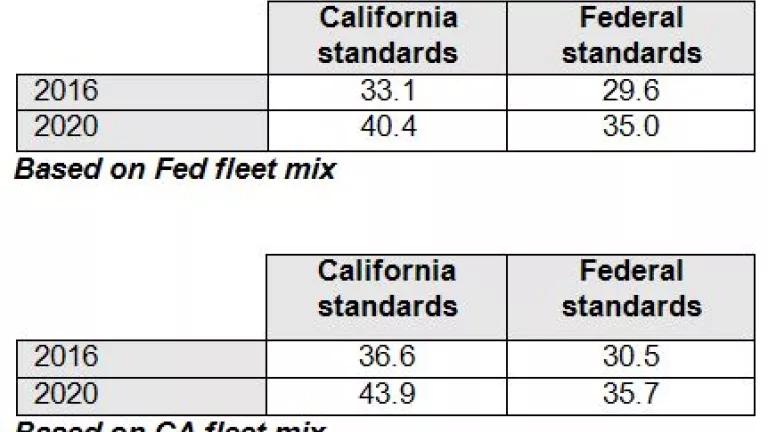
John Adams, our second president, famously said: "Facts are stubborn things." In a 1988 slip of the tongue, Ronald Reagan said: "Facts are stupid things." For the Bush administration, the slip of the tongue has been going on for seven years.
Here's the latest from the fact-free zone. Last month, when denying California the right to set its own standards for global warming pollution from new cars and SUVs (see my previous post), Bush's EPA administrator, Stephen Johnson, claimed California's global warming standards are weaker than the fuel economy standard in the newly enacted energy bill.
In his December 19th get-lost letter to Gov. Arnold Schwarzenegger, Johnson wrote: "I strongly support this national approach to this national challenge which establishes an aggressive standard of 35 miles per gallon for all 50 states, as opposed to 33.8 miles per gallon in California and a patchwork of other states."
Huh? If California's standards are weaker, then why are the car companies so opposed to them?
Well, for starters, Johnson was comparing apples and oranges. He was comparing the federal miles per gallon (mpg) standard for 2020 with the mpg level he attributed to the California emissions standards for 2016.
That might be okay in fantasy baseball. It may be fun to ask if Babe Ruth could have hit 60 home runs against today's pitching. But the EPA administrator shouldn't be playing fantasy carbon regulation.
In fact, lined up year-by-year, the California standards are always stronger. This is true whether you are comparing them on the basis of greenhouse gas reductions or mileage. And it is true whether you are looking at California alone, or the nation as a whole.
As Mary Nichols, chairwoman of the California Air Resources Board, put it: "[The] California standards start earlier, go faster ... and the end points are more stringent."
Let's look more closely at Johnson's math. The EPA administrator supplied no documentation for his calculations. (My high-school son can't get away with that when he turns in his math homework.) In contrast, the California Air Resources Board (CARB) prepared its own fully-documented comparison of the California emission standards and the federal mileage standards.
CARB's analysis compares apples to apples, matching up the California global warming standards and federal mileage standards year for year. No more comparing federal standards for 2020 with state standards for 2016.
Now the new energy law says the mileage standard must reach at least 35 miles per gallon by 2020, but doesn't spell out the mileage standards for the intervening years. The federal Department of Transportation (DOT) still has to write the miles per gallon standards for 2011 through 2019. So to fill this gap, CARB assumes that the federal DOT will increase the mileage standards proportionally each year. In that case, CARB calculates that the federal standard will be only 29.6 mpg in 2016.
Last time I checked, 33.8 was bigger than 29.6.
Ka-ching!
(CARB actually found a small difference between its estimate of the mpg value of its 2016 standards (33.1 mpg) and the number ascribed to the California standards in EPA administrator Johnson's letter (33.8 mpg). As I said earlier, because Johnson didn't "show his work," no one knows how he got his number. But whether equivalent to 33.1 or 33.8, the California global warming standards beat 29.6.)
CARB then translated the federal mileage standards into reductions in global warming pollution and compared them in the years through 2016. CARB did this first for California's vehicle fleet.
CARB found that in California, the state's standards reduce global warming pollution more than twice as much as the federal standards in 2016. Looking at cumulative reductions from 2009 through 2016, California's standards cut heat-trapping gases three times as much as the federal standards.
Ka-ching!
That's for the fleet mix in California, which has more cars than SUVs and other light trucks (70 percent cars, 30 percent light trucks). You get the same result for the national fleet mix (50 percent cars, 50 percent light trucks). If applied across the country, in 2016 the California standards would cut heat-trapping gases 75 percent more than the federal mileage standards.
Ka-ching!
California doesn't stop in 2016. CARB has announced plans to strengthen its standards through 2020 (here, p.45). CARB's current analysis shows that California's 2020 standards will vastly outperform the federal mpg standard in 2020 as well, reducing global warming pollution nearly 75 percent more based on the California fleet mix, and nearly 60 percent more if applied nationally.
Ka-ching!
For good measure, CARB converted its own global warming standards into miles per gallon. California comes out way ahead this way too:
Ka-ching!
Well, let's go back to EPA administrator Johnson's fuzzy math.
Slips of the tongue happen (even in a written letter). But even after being called on his mistakes, Johnson didn't take the opportunity to correct himself. Instead, Johnson had his spokesman repeat his bogus 2020-vs.-2016, 35-vs.-33.8 comparison when the state and environmental coalition took him to court on January 2nd.
Once is a slip. Twice is deliberate.
EPA administrator Steven Johnson is a trained scientist. Scientists are supposed to be able to count. Scientists are supposed to have a respect for facts. Facts are not supposed to be stupid things.

